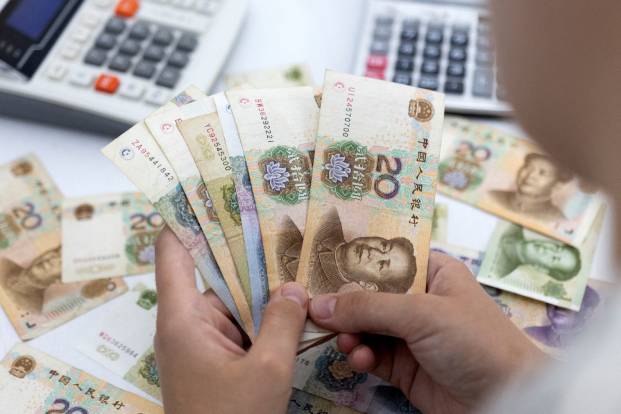The People’s Bank of China cut its one-year and five-year loan prime rates (LPR) by 10 basis points on Tuesday.
The move – the first easing in 10 months – came as authorities sought to boost its slowing economy, and led to the yuan falling to seven-month lows.
The decision knocked the yuan lower in Asian trading and it last fell 0.2% in onshore trade to 7.1747 per dollar, not far from last week’s nearly seven-month low of 7.1819.
Similarly, the offshore yuan was more than 0.1% lower at 7.1761 per dollar, languishing near last week’s trough of 7.1916, its lowest since late November.
ALSO SEE:
China Bankers to Shun ‘High-End Taste’ Fearing Regulatory Ire
Aussie dollar drops on dovish RBA minutes
“Markets were expecting bigger support and were hoping for a larger LPR cut,” currency strategist Christopher Wong at OCBC said. “The delivery of a smaller LPR cut came as a signal of lesser support and the disappointment was felt in softer (yuan).”
Investors continue to be on the lookout for greater government support measures, as a faltering post-pandemic recovery has kept sentiment fragile.
“The playbook may be slightly different, in a sense that it’s not going to be a big bang stimulus. It’s probably going to be more targeted,” currency strategist Moh Siong Sim at Bank of Singapore said.
The Australian dollar also fell after minutes from the Reserve Bank of Australia’s last meeting showed that keeping interest rates unchanged was under consideration.
The Aussie dollar tumbled as much as 0.7% to a session low of $0.6798 after minutes from the RBA’s recent policy meeting released on Tuesday showed its decision to hike interest rates in June was “finely balanced”.
“The minutes were interpreted by market participants as dovish,” currency strategist Carol Kong at Commonwealth Bank of Australia said. “As a result, markets have pared back their expectations for the RBA cash rate, so that weighed on the Aussie.”
Yen also falls, while Euro and pound rise
The New Zealand dollar fell 0.17% to $0.6188, and the yen slumped to a seven-month low of 142.26 per dollar. That extended its decline following the Bank of Japan’s (BOJ) decision on Friday to maintain its ultra-easy monetary policy.
The yen has come under renewed pressure amid rising interest rate differentials between Japan and other developed markets.
“We believe that Japan’s economy is recovering solidly compared to other major economies and will continue to outperform in the future. But, if monetary policy fails to reflect this shift of economic fundamentals and the BOJ keeps its dovish policy, then the yen should depreciate even more,” Min Joo Kang, ING senior economist for South Korea and Japan, said in a client note.
The euro rose marginally to $1.0923, drawing support from a still-hawkish European Central Bank after two policymakers on Monday said the bank should err on the side of further rate hikes as the inflation rate could come in even higher than it expects.
Sterling edged 0.06% higher to $1.2798, ahead of British inflation data and the Bank of England’s (BoE) interest rate decision later in the week.
Markets are expecting the BoE to deliver a quarter-point rate hike on Thursday, which would be its 13th consecutive rise as the bank fights unexpectedly sticky inflation.
“The market has continued to increase pricing expectations of not only a delivery of potentially more than 25 basis points this week, but (also) higher terminal rates,” Rodrigo Catril, senior currency strategist at National Australia Bank, said.
“To some extent, we think that the pricing has become a little bit too aggressive in terms of what we think the Bank of England needs to do.”
Against a basket of currencies, the US dollar steadied at 102.47.
- Reuters with additional editing by Jim Pollard
ALSO SEE:
China’s Xi Puts a Positive Spin on Talks With Blinken
Japan Megabanks Sounded Out Over China Exposure Risks
US Can’t Yet Compete With China on EVs, Ford Chairman Says
Chinese Companies Prepare for Weaker Yuan as Rate Cuts Loom
























